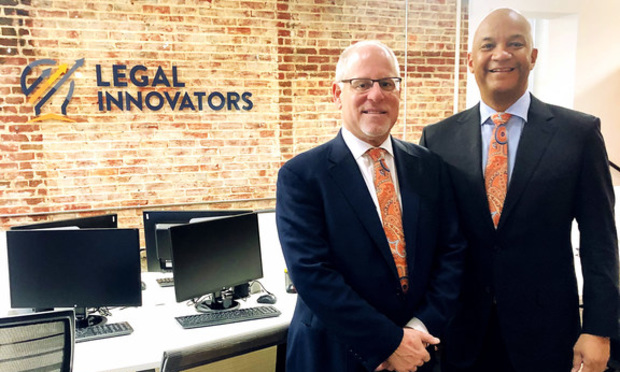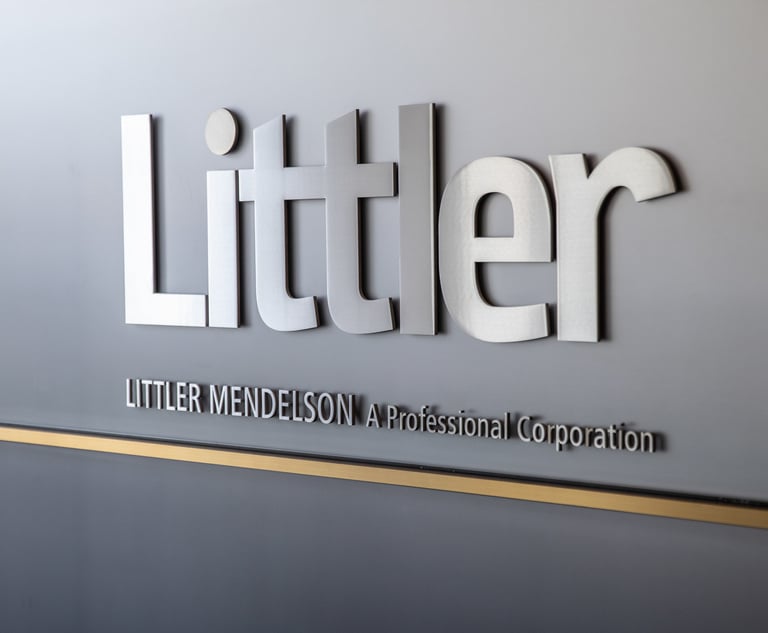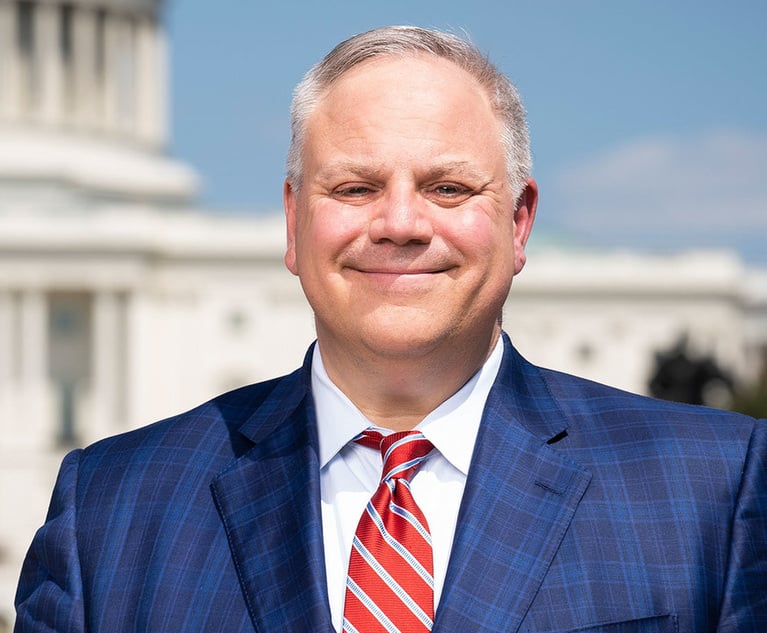Shearman Vet, Silicon Valley CEO Aim to Upend Legal Talent Market With New Startup
Legal Innovators aims to give law students a back door into prestigious law firms while offering these firms and corporate law departments a way to keep costs down on entry-level attorneys.
December 09, 2019 at 05:41 PM
8 minute read
 Jonathan Greenblatt, chairman, left, and Bryan Parker, CEO, right, of Legal Innovators (courtesy photo)
Jonathan Greenblatt, chairman, left, and Bryan Parker, CEO, right, of Legal Innovators (courtesy photo)
A former Shearman & Sterling partner and a Silicon Valley business leader who started his career at the firm believe not only that they've spotted an inefficiency at the heart of the Big Law hiring model, but that they've found a way to solve it.
Legal Innovators, the new startup from longtime Shearman international arbitration attorney Jonathan Greenblatt and veteran technology and services CEO Bryan Parker, promises to give law students a back door into prestigious firms while offering these firms and corporate law departments a way to keep costs down on entry-level attorneys.
"The market is in a weird place," Greenblatt said.
While at the start of his career 30 years ago, only a few Wall Street firms and several other elites in Washington, D.C., were offering top-of-the-market salaries, the number of players offering the upper standard, now close to $200,000, has grown. At the same time, most firms no longer look to students farther along in law school, who might not have clicked at their summer associate placement or performed markedly better in their second year compared to their first.
"It was my supposition that a lot of people in the third year of law school were competitive with the people that were getting in the door, but were finding not as many options as they anticipated," Greenblatt said.
Meanwhile, firms are facing increased pressure from clients who balk at the rates they are paying for entry-level associates.
Legal Innovators aims to solve the issue by hiring, mentoring, and training a pool of young attorneys, and offering them to firms and corporate law departments who recognize the value of bringing in talent to perform associate-level work at a cheaper rate than the industry standard.
"In today's market, they're much more willing to pay for senior people than junior people," Greenblatt continued. "We can rationalize the price point—bring real estate and salary down—so that the firm can supervise their work, be comfortable with the quality level, and do it at a lower price point or offer fixed fees or caps, and get work they're otherwise not able to get."
The company unveiled its offering last week, with its inaugural class of 16 "law clerks" out of Georgetown University Law Center, George Washington University Law School, and Howard University Law School. CEO Parker, who relocated to D.C. to start the operation, and chairman Greenblatt made clear to the deans at the three schools they were looking to recruit candidates who could compete with students who were headed to Big Law. But there was one other crucial criterion.
Parker, who is African American, recalls reading an article in 1997, when he was a second-year associate at Shearman, calling out Big Law for its poor performance on diversity. Twenty-two years later, minorities remain underrepresented. That's particularly pronounced for African Americans: the National Association for Legal Placement says that their representation, at 4.48% of associates, is actually lower than the 2009 level. Parker said that internally, the company is setting a goal for 20% African American hiring.
"I think we can do something about this hard and intractable problem," he said. The first Legal Innovators class has a 50% male-to-female-student ratio, and 50% of its lawyers are minorities.
Greenblatt and Parker also recognize that young lawyers have different goals now than those of their generations.
"Lawyers are still a bit conservative by nature, despite the things people want to say about millennials, but they're not afraid to take risks," Parker said. "They're not totally sold on going for the brass ring of the partnership."
A 'Bridge' To Big Law
Law clerk Apple Seibert had initially gone to George Washington University Law School with the goal of getting into international human rights work. She participated in the Big Law on-campus interview process as a 2L, but wound up working for the government both of her summers in law school. She learned about Legal Innovators through a posting at the school's career center.
"I'd never worked in Big Law, but I thought I would try it to see if it's something I'd be interested in," she said. "If it turns out that I hated it, I could do something else."
The company doesn't promise that its clerks will land a permanent placement with a firm after two years, but it's a goal. Parker, citing the quip that firms only hire first and second-year associates so they can have midlevel associates, is placing a bet that they will ultimately welcome the opportunity to trim the costs of acquiring a class of new attorneys and employing them for the first two years. They can then turn to Legal Innovators to land trusted talent with two years of experience under their belt.
John McMillan is counting on that to be the case. The George Washington graduate struck out on roughly 30 on-campus interviews after his 1L summer, but remains committed to a career as a transactional attorney.
"[Legal Innovators] serves as a bridge for people like me and my colleagues who believe we should be in Big Law, but for whatever reason, the system didn't work for us," he said. "We sort of fell through the cracks, and it's a net for those people who could contribute."
To this end, the company is investing heavily in training for its hires. Seibert and McMillian, who are still awaiting their first placement after starting in October, are currently developing skills in Excel, legal writing and in specific practice areas. Once placed, clerks will be subject to monthly tracking of how their assignments and training are progressing.
"The idea is that at the end of the year they're going to have a story to tell about their training, assignments, and the levels of their competencies," said Edge International principal David Cruickshank, who is advising the company on training. "Even a year-end evaluation of a first-year associate at a law firm does not have that level of detail, and level of sophistication."
In the end, the success of the venture will rest on whether firms can trust that lawyers hired after two years at Legal Innovators can hit the ground running. If these attorneys can't get work, the company's talent pool will dry up.
Cruickshank, who previously served as director of professional development at Paul, Weiss, Rifkind, Wharton & Garrison, noted that managers at firms will face three options for filling out the ranks of midlevel associates, putting aside the obvious superstars in each cohort: middling internal associates, Legal Innovators associates who have done a placement in the firm, and outside candidates.
"Given the three, I think their associate has an advantage over a person off the street and is going to be competitive with the person I've got the question mark about," he said.
Although the company is starting small, with one open-plan office in Washington that both keeps real estate costs low and contributes to the startup atmosphere, Greenblatt and Parker both have growth on their minds.
"I've run pilots in my past experience," Parker said. "Jon and I look at this in the same way. We want to start with 16, and increase that in our second and third years and beyond."
Geographical expansion is also a goal for the pair, who have financed the initial investment through sweat equity and a small "friends and family" seed round. They're now working on an addition to support sales, marketing, and operations as they scale up. An office in New York is a must, while Parker said it would be possible to serve markets such as Boston and Philadelphia on a hub-and-spoke model. Other places they'd like to explore in the future include Miami, Chicago, Los Angeles, and San Francisco, along with London, UAE, Singapore, and Hong Kong.
"It's a highly leveraged model," Parker said. "You have fixed costs but as you get penetration and ramp up realistically, there's a fairly quick and smooth transition to break even. The business doesn't need the cash until you enter into wholesale expansion or M&A."
Read More
From Glass Walls to Free Snacks, Associates Dish on What They Love, Hate and Fear
Can Law Firms Keep Young Lawyers Happy?
The Legal Talent Market Faces Tectonic Jolts
This content has been archived. It is available through our partners, LexisNexis® and Bloomberg Law.
To view this content, please continue to their sites.
Not a Lexis Subscriber?
Subscribe Now
Not a Bloomberg Law Subscriber?
Subscribe Now
NOT FOR REPRINT
© 2025 ALM Global, LLC, All Rights Reserved. Request academic re-use from www.copyright.com. All other uses, submit a request to [email protected]. For more information visit Asset & Logo Licensing.
You Might Like
View All

Three Akin Sports Lawyers Jump to Employment Firm Littler Mendelson

Brownstein Adds Former Interior Secretary, Offering 'Strategic Counsel' During New Trump Term
2 minute read
Law Firms Mentioned
Trending Stories
Who Got The Work
J. Brugh Lower of Gibbons has entered an appearance for industrial equipment supplier Devco Corporation in a pending trademark infringement lawsuit. The suit, accusing the defendant of selling knock-off Graco products, was filed Dec. 18 in New Jersey District Court by Rivkin Radler on behalf of Graco Inc. and Graco Minnesota. The case, assigned to U.S. District Judge Zahid N. Quraishi, is 3:24-cv-11294, Graco Inc. et al v. Devco Corporation.
Who Got The Work
Rebecca Maller-Stein and Kent A. Yalowitz of Arnold & Porter Kaye Scholer have entered their appearances for Hanaco Venture Capital and its executives, Lior Prosor and David Frankel, in a pending securities lawsuit. The action, filed on Dec. 24 in New York Southern District Court by Zell, Aron & Co. on behalf of Goldeneye Advisors, accuses the defendants of negligently and fraudulently managing the plaintiff's $1 million investment. The case, assigned to U.S. District Judge Vernon S. Broderick, is 1:24-cv-09918, Goldeneye Advisors, LLC v. Hanaco Venture Capital, Ltd. et al.
Who Got The Work
Attorneys from A&O Shearman has stepped in as defense counsel for Toronto-Dominion Bank and other defendants in a pending securities class action. The suit, filed Dec. 11 in New York Southern District Court by Bleichmar Fonti & Auld, accuses the defendants of concealing the bank's 'pervasive' deficiencies in regards to its compliance with the Bank Secrecy Act and the quality of its anti-money laundering controls. The case, assigned to U.S. District Judge Arun Subramanian, is 1:24-cv-09445, Gonzalez v. The Toronto-Dominion Bank et al.
Who Got The Work
Crown Castle International, a Pennsylvania company providing shared communications infrastructure, has turned to Luke D. Wolf of Gordon Rees Scully Mansukhani to fend off a pending breach-of-contract lawsuit. The court action, filed Nov. 25 in Michigan Eastern District Court by Hooper Hathaway PC on behalf of The Town Residences LLC, accuses Crown Castle of failing to transfer approximately $30,000 in utility payments from T-Mobile in breach of a roof-top lease and assignment agreement. The case, assigned to U.S. District Judge Susan K. Declercq, is 2:24-cv-13131, The Town Residences LLC v. T-Mobile US, Inc. et al.
Who Got The Work
Wilfred P. Coronato and Daniel M. Schwartz of McCarter & English have stepped in as defense counsel to Electrolux Home Products Inc. in a pending product liability lawsuit. The court action, filed Nov. 26 in New York Eastern District Court by Poulos Lopiccolo PC and Nagel Rice LLP on behalf of David Stern, alleges that the defendant's refrigerators’ drawers and shelving repeatedly break and fall apart within months after purchase. The case, assigned to U.S. District Judge Joan M. Azrack, is 2:24-cv-08204, Stern v. Electrolux Home Products, Inc.
Featured Firms
Law Offices of Gary Martin Hays & Associates, P.C.
(470) 294-1674
Law Offices of Mark E. Salomone
(857) 444-6468
Smith & Hassler
(713) 739-1250









